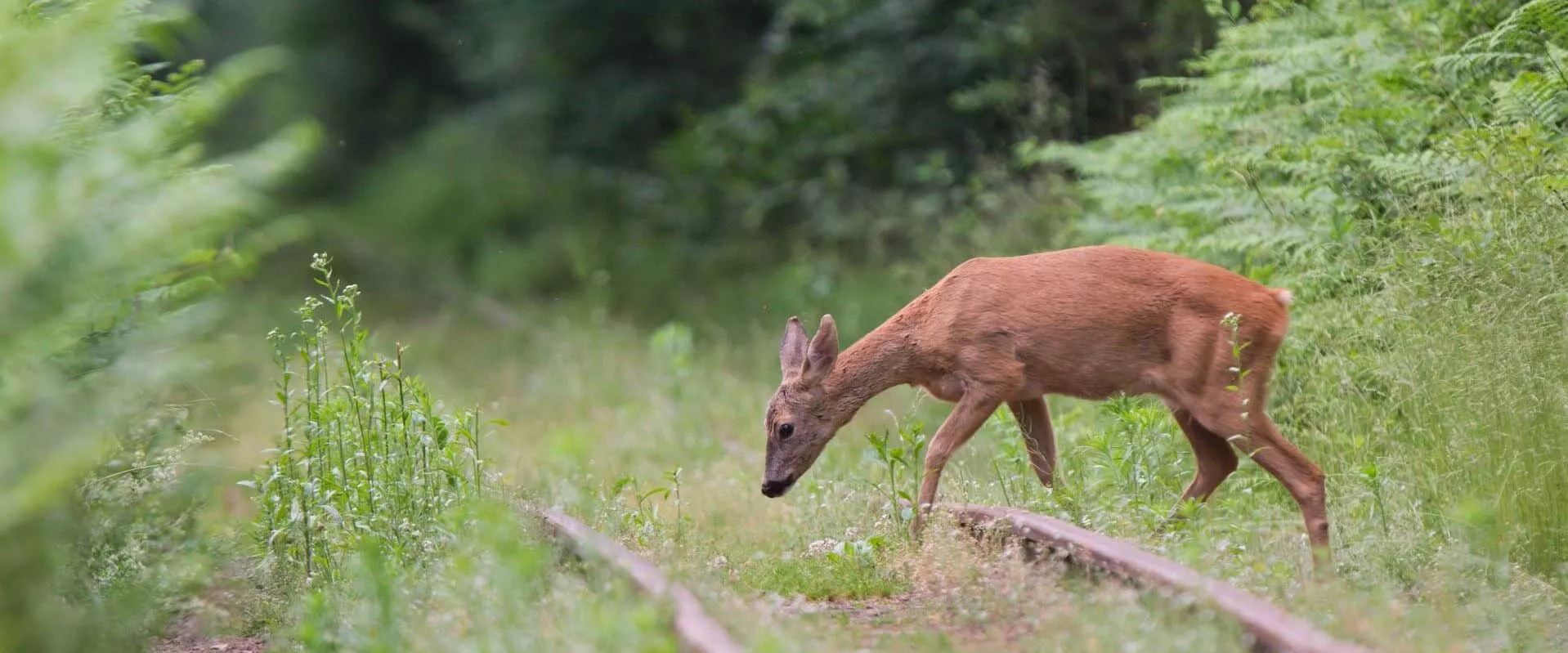
Wildlife on the line: how we manage
When animals stray too close to the tracks, rail traffic and rail safety can take a hit—literally. For safety’s sake, drivers reduce train speed to avoid collisions as soon as animals are spotted. But we’re also taking targeted action to minimize risk and keep trains running on time.

Wildlife collisions caused
302,343
minutes of delays across the network in 2024

2,562
animals hit by trains in 2024

€2.17 mn
in costs (equipment and labour, excl. TGVs) in 2024
Step one: inspect the trainset
If a train hits a wild boar or other animal, traffic is suspended in the affected area, and the driver stops to assess the train’s condition:
If the damage is slight, the animal is removed from the tracks, and the train can safely resume its journey.
If the damage is too severe, we send in specialized crews to check whether the train can remain in operation. Collisions can impair brakes and other critical components at the point of impact.
Assessing and repairing the damage takes time and can cause delays. In some cases, passengers may have to transfer to another train to complete their journey.
Solutions: how different teams are tackling the challenge
Reinforcing rolling stock
Specifications for our trains’ power cars now call for parts with multiple components that drivers can quickly assess and replace as necessary. We’ve also strengthened the skirting that protects the front of locomotives to limit the impact of collisions and make maintenance easier.
Example: Intercité trains now feature bumpers to shield critical brake valves on the front of its BB 26000-class locomotives. If these valves were destroyed in a collision, trains might be immobilized in place for lengthy repairs, causing significant delays on the line.
Adapting infrastructure
Wild animals need freedom of movement to meet their basic needs, and SNCF Réseau is working hard to reduce their risk of collision with passing trains. For new infrastructure, we use environmental studies to identify where animals are likely to cross our lines and how we can accommodate them with special passageways that let them safely through.
On high-speed lines:
- we regularly maintain fencing and reinforce areas where it has been cut, torn away or pushed up by burrowing animals
- we send out specially trained wildlife managers, who monitor our lines and step in when animals make their way onto rail property despite our best efforts
- we install special devices such as Faun’Trap® and Sanglipass® to let animals exit rail enclosures safely
On classic lines:
- we perform regular and intensive maintenance in areas of dense growth where large animals take shelter on rail property
- we carry out studies to identify high-risk areas and determine the best action to take
- we modify existing under- and overpass structures in high-risk areas to encourage animals to use them. To steer wildlife to these safer passageways we install ballast and gravel, create grass strips, add plantings, and build fences.
- we limit access to the most dangerous areas for wildlife, such as heavily excavated areas and rock cuts, by installing Strail Grid® and other devices
- we install fences in areas with the highest accident rates
- we are experimenting with noise deterrents.
Experiments with sounding the alarm
A few years ago, our Innovation & Research department started testing noise deterrents to keep large mammals away from railway tracks. These deterrents use either existing sound signals or synthetic, biomimetic sounds generated by passing trains or triggered by trackside transmitters.
Several real-world tests have been conducted in France, in partnership with SNCF Réseau and TER. Dr. Anna Terrade, a bio-acoustics expert, explains the approach in the video below. If the results prove conclusive, the noise deterrents will be deployed across the network once testing is complete.
We create noise deterrents to keep wild animals off the tracks
Testing noise and light deterrents in Normandy
Following conclusive results in Pays de la Loire—where it reduced collisions by 90% in just one year—Blue Sentinel, an innovative system that combines noise and light deterrents, has been deployed in Normandy since October 2025. SNCF Réseau is currently testing the system on a section of the Rouen–Caen line that passes through the Londe Forest, where nearly 50 wildlife collisions have occurred since 2019. Autonomous transmitters positioned at regular intervals along a 5.5 km stretch of track, activate in sequence as trains approach, safely scaring animals away before they pass. If the results are positive, similar deterrents could be rolled out along the Paris–Caen–Cherbourg line.
Raising awareness and maintaining a dialogue with local stakeholders
Intensive dialogue
We maintain intensive dialogue with farmers, hunting groups, local property owners and government agencies to address the increasing density of wildlife populations—primarily wild boar, deer and burrowing animals that can destabilize tracks by digging underground.
Drones help tackle wild boar problems in Normandy
Wild boar are a growing hazard for trains in eastern Normandy, and regularly cause collisions and service disruptions. To address the issue, SNCF Réseau has teamed up with local hunters for an innovative solution.
Using drones equipped with thermal cameras, hunters track the boars’ movements and identify where they cross railway tracks. This crucial information is then passed on to SNCF Réseau, which installs small, removable grids to guide the animals safely across, reducing risks for both wildlife and train passengers.
An ongoing information campaign
In the areas most at risk, we continually raise awareness among local property owners and contractors working near the tracks. We remind them of safety guidelines, as well as the risks and sanctions they may incur when hunters, dogs, and domestic or farm animals stray onto rail right-of-ways and other land.
In the field with a wildlife manager
Share the article